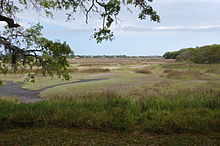Golden Isles of Georgia
[2] Curled around its north end and accessible only by boat is Little St. Simons Island—privately owned and maintained in its natural state with a small capacity guest lodge and cottages.
[3] During World War II, Brunswick hosted an important construction site for Liberty ships, and Naval Air Station Glynco, a major operational base for blimps.
[4] Other key components of the local economy include the Port of Brunswick, Federal Law Enforcement Training Center, aviation support services, and manufacturing.
Reachable via the F. J. Torras Causeway, the Island is a tourist destination for its beaches, water sports, boating and fishing, golf, nature trails, historical landmarks, shopping, restaurants and nightlife.
Near the Coast Guard beach is the Bloody Marsh battle site where in 1742, a small garrison of British troops defeated a much larger Spanish force and in the process, put an end to Spain's influence north of Florida.
Due to the mild climate, outdoor activities are common year-round, including hiking, bicycling, canoe and kayaking, paddle-boarding, offshore and inshore fishing and beachcombing.
[12] After the Panic of 1907, Senator Nelson Aldrich convened secret meetings of prominent bankers at the Club, under the guise of a duck hunting trip, to formulate plans for a central banking structure, which ultimately became the basis for the Federal Reserve System.
Mary Ross Park on the East River hosts a variety of events including concerts, weddings, a farmer's market, and the annual Brunswick Stewbilee.
During this time, a Scottish nobleman, Sir Robert Montgomery, who envisioned a utopian colony between the Savannah and Altamaha rivers, published "A Description of the Golden Islands"[19] in London (1720).
By the 1730s, the Native American population had declined, and Great Britain had prevailed to the extent of founding the colony of Georgia under the leadership of Gen. James Oglethorpe, who established the city of Savannah.
[23] Even before the Civil War, Island plantations had begun their decline due to a dramatic slackening of English demand, lack of crop rotation for soil management, and absentee ownership.
During World War II, blimps from Glynco Naval Air Station in Brunswick patrolled the Atlantic, protecting convoys and looking for German U-boats that frequented the area.
The area's most distinctive characteristic, its extensive marshes and estuaries, provide an abundance of food plus breeding grounds for a multitude of land, sea, and air creatures.
Commonly seen along the beaches and the adjacent maritime forests are several species of shorebirds, including egrets, herons, white ibis, gulls, terns, plovers, sandpipers, pelicans, and ospreys.
[34] These groups monitor, protect and manage nests found on Golden Isles beaches, in addition to conducting research and public awareness and education programs.
[37] Because of its long and varied history and mixture of disparate peoples, the Golden Isles enjoys a rich cultural heritage that locals work to preserve in a variety of ways.
The Golden Isles are located near the southern end of the Gullah Geechee Cultural Heritage Corridor, a coastal area that stretches from Wilmington, NC to Jacksonville, FL, extending 30 miles inland along its length.
A Brunswick Stew cooking contest coupled with a 5K run, live entertainment, kids fun zone, antique car show plus arts and crafts.
Interactive exhibits and displays offer the latest information about coastal weather, native plants, recycling, sea turtles, water conservation, archeology, herpetology, and geology.
Food tastings at the Pier Village, several concurrent events at area restaurants, artisan market, cooking classes and demonstrations, children's activities, Sunday brunch.
The nutrient-rich waters of the Golden Isles marshes, tidal creeks, rivers, sounds and the Atlantic Ocean are home to an extensive variety of fish and sea creatures, which in turn draws anglers from near and far.
[54] With the advent of the automobile and the opening of the F. J. Torras Causeway in 1924, more facilities were built (most notably by auto magnate turned developer, Howard Coffin) and it was not long before St. Simons Island became a preferred vacation destination.
[citation needed] Originally, the Grand Opera House, a three-story Victorian building featuring ornate brick and stone work, was built for the legitimate stage.
In May 2011, local company Fendig Signs undertook extensive restoration work, including painting, rewiring, and the crafting of new neon letters by Ray Tanner.
The restored sign was returned in the fall and on November 4, 2011, during Downtown Brunswick's First Friday event, Golden Isles Arts and Humanities held a grand re-lighting celebration.
Its gleaming heart-pine and marble floors, original vintage fireplaces and newly refitted gaslight fixtures lend an air of old fashioned elegance to any gathering.
Massive in stature, with the unusual addition of Italianate brackets, Romanesque Revival architecture was the style of choice for the majority of public buildings built in the United States during this period.
[60] 610 Beachview Drive, St. Simons Island, GA 31522 When the property was purchased in 1949, it was Bishop Moore's vision that it would one day become a retreat center and a place of inspiration for people of all ages.
Dr. Charles Layman, noted theologian, writer, and professor of Bible at the University of Florida, graciously offered to the museum items from his extensive Wesleyan collection.
Owned by the St. Simons Land Trust, the Preserve includes salt marsh, tidal creek, and river shoreline, as well as 4,000-year-old shell middens and ruins of a 17th-century plantation home and slave quarters.

















